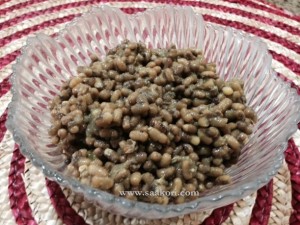Indian Style Savory Mung Beans
I love mung beans for breakfast.
They are a great source of protein for vegetarians, filled with fiber, great for gentle detoxing and light on the stomach. There are a couple of ways I make them, but I’ll share one today and keep the other recipe for a another time.
Since this recipe is savory, you can have it for breakfast, for lunch or dinner as a main dish or even as a side dish if you like. This is one versatile dish which you can cook and use as per your convenience. Its a common recipe for us Maharashtrians (people from the western coastal part of India. Think Mumbai region and the surrounding areas).
Ingredients:
- 1 cup green mung beans (washed and soaked overnight)
- 1/2 tsp mustard seeds
- 3/4 tsp turmeric powder
- 1″ piece of jaggery (or honey if you prefer)
- 1/2 tsp red chili powder or 1 small green chili
- 1 tbsp. tamarind concentrate (or lemon juice if you prefer)
- 1″ fresh ginger root, grated
- 1 tbsp. cold pressed organic coconut oil
- 1 tsp garam masala (optional)
- shredded coconut to taste (for garnish)
- salt to taste
Note:
- Wash and soak the mung beans overnight.
- In the morning, rinse and drain the water. Using the soaking water may cause gas.
Directions:
- In a hot pan, put the coconut oil and let it heat.
- Add the mustard seeds and let them crackle.
- Add turmeric powder, red chili powder, ginger root, and the garam masala.
- Stir and add the soaked mung beans, tamarind concentrate, jaggery piece and salt.
- The sweetness of jaggery / honey will counter sour tamarind paste.
- Add 1-2 cups of water, depending on the desired consistency.
- Keep stirring occasionally. it might take upto 30 mins or more to cook until the mung beans are soft. Or you can make this in the slow cooker too!
- The dish in the picture here is pretty dry, but you can make them with more water if you plan to serve it as a gravy with rice or quinoa.
- The drier version can be eaten with salads, as lettuce wrap, with bread or naan- or just by itself.
- I’ve eaten it cold during summer for breakfast or hot on cooler days. As I said this is one versatile dish you can eat in many ways.
Let me know how it goes, I always love to hear from you!
Sign up here for our Email Club and never miss on an upcoming new recipe, blog or nutrition tips/ resources.






